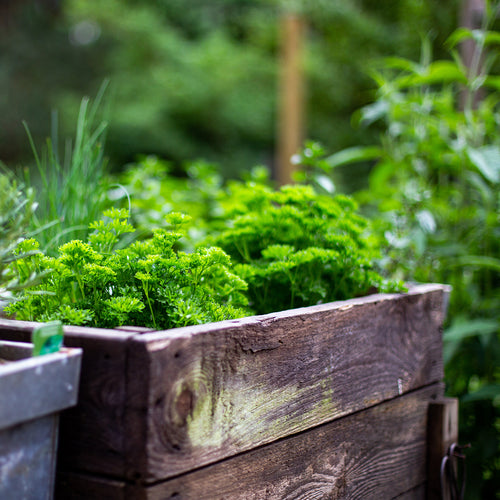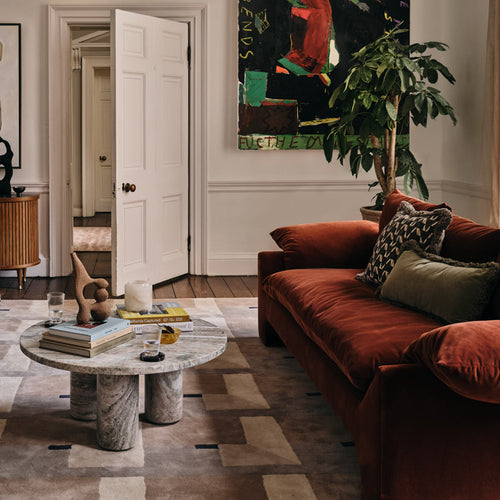THROUGH THE FAWN LENS
Embracing Nature's Palette: A Guide to Organic Colours in Interiors
Organic colours, inspired by the beauty of the natural world, bring a sense of tranquility, balance, and connection to the outdoors into your living space. These hues evoke feelings of calmness, restoration, and understated elegance. If you're looking to create a warm and inviting atmosphere that promotes relaxation and well-being, then organic colours are the perfect choice for your interior design.

Image: our Lymington project
UNDERSTANDING ORGANIC COLOURS
Organic colours encompass a wide range of shades and tones found in nature. Think of lush greens, earthy browns, calming blues, and sandy beiges. These colours often appear muted and desaturated, lacking the harsh vibrancy of their synthetic counterparts. Here's a breakdown of some key organic colour groups:
Earthy Tones: This group forms the foundation of organic palettes. Colours like warm browns (think tree bark or rich soil), taupes, and terracotta evoke a sense of grounding and stability.
Greens: From the vibrant greens of young leaves to the deep, mossy tones of the forest floor, greens bring the freshness and life of nature indoors. Muted sage greens and olive greens create a sense of peace and tranquility, while brighter greens like seafoam or celadon can add a touch of energy.
Blues: Inspired by the calming vastness of the sky and the ocean, blues play a significant role in organic palettes. Soft blues like sky blue or denim create a sense of serenity, while teals and muted turquoises add a touch of coastal charm.
Neutrals: Creams, beiges, and whites derived from nature (think sand, pebbles, or eggshells) provide a neutral backdrop for bolder organic colours. They add a sense of airiness and spaciousness, allowing the other colours to shine.
Accents: While organic palettes tend towards muted tones, pops of colour inspired by nature can add vibrancy. Think of burnt orange (like autumn leaves), dusty rose (inspired by desert blooms), or mustard yellow (mimicking wildflowers). Use these colours sparingly for a touch of personality.
THE BENEFITS OF ORGANIC COLOURS IN INTERIOR DESIGN
Promotes Relaxation and Well-being: Organic colours have a calming effect on the mind and body. Studies have shown that exposure to nature, including natural colours, can reduce stress, lower blood pressure, and improve mood.
Creates a Sense of Connection to Nature: By incorporating these colours into your home, you can bring the outdoors in and create a more harmonious relationship with the natural world.
Versatility and Timelessness: Organic colour palettes are inherently versatile and can be adapted to various design styles, from rustic farmhouse to modern minimalist. Their timeless nature ensures your space remains elegant and sophisticated for years to come.
Enhances Lighting: Organic colours generally reflect light well, making your space feel brighter and more airy. This is particularly beneficial in rooms with limited natural light.
USING ORGANIC COLOURS IN YOUR INTERIOR DESIGN
Now that you understand the essence of organic colours, let's explore how to incorporate them into your living space:
Choosing a Base Colour: Start by selecting a dominant organic colour for your walls, furniture, or flooring. This will set the overall tone of the room. Earthy tones like taupes or light browns are popular choices for creating a warm and grounded atmosphere. Muted greens or soft blues can evoke a sense of tranquility, while creams and beiges provide a neutral backdrop.
Layering Colours: Once you have your base colour, layer in other organic hues to add depth and interest. Consider using a slightly darker shade of your base colour for furniture or accents. Introduce pops of colour with throw pillows, artwork, or decorative objects.
Texture and Materials: Organic colours pair beautifully with natural textures and materials like wood, stone, wicker, linen, and cotton. These elements further enhance the connection to nature and create a sense of warmth and comfort.
Lighting: Natural light is crucial when using organic colours. Maximise natural light by keeping windows uncluttered and using sheer curtains. Consider warm-toned lighting fixtures to complement the natural colour palette.
Plants and Greenery: Live plants are the ultimate way to bring the outdoors in. They not only add a touch of colour with their vibrant foliage but also purify the air and enhance the overall feeling of well-being.
Here are some additional tips for using organic colours in specific rooms:
Living Room: Create a cosy and inviting atmosphere with a combination of earthy browns, warm beiges, and pops of burnt orange or mustard yellow.
Bedroom: Opt for calming colours like soft blues, sage greens, and lavenders to promote relaxation and restful sleep.
Kitchen: Light and airy colours like creams, whites, and light grays paired with natural wood tones create a clean and refreshing space. Accent with pops of colour like light turquoise or seafoam green for a touch of coastal charm.
Bathroom: Similar to the bedroom, use calming blues, greens, and neutrals to create a spa-like retreat. Consider textured tiles or stone countertops for a touch of natural elegance.
Home Office: Earthy tones like taupes and browns can create a sense of stability and focus, while muted greens can promote creativity and productivity.
BEYOND ROOMS
Organic colours aren't limited to just walls and furniture. Here are some additional ways to incorporate them into your home:
Flooring: Consider natural stone tiles, hardwood floors in warm brown tones, or woven rugs in beige or green hues.
Artwork and Accessories: Artwork depicting natural landscapes, botanical prints, or sculptures made from natural materials like wood or stone will complement your organic colour scheme.
Outdoor Living Spaces: Extend your organic colour palette to your patio, deck, or balcony. Use furniture made from recycled wood or natural fibers, and incorporate potted plants and flowers for a cohesive look.
Remember, these are just guidelines. Don't be afraid to experiment and personalise your space. Here are some additional considerations:
Balance: When using multiple colours, ensure a sense of balance. A good rule of thumb is the 60-30-10 rule, where 60% of the space is your dominant colour, 30% is a secondary colour, and 10% is an accent colour.
Light: Consider the amount of natural light in the room when choosing colours. Darker organic colours can work well in rooms with ample natural light, while lighter colours might be more suitable for rooms with less light.
Personal Preference: Ultimately, the best way to choose organic colours for your home is to select shades that resonate with you and create a feeling of peace and tranquility.
Incorporating organic colours into your interior design is a beautiful way to create a calming, inviting, and stylish space that reflects the natural world. By embracing these timeless hues and textures, you can transform your home into a haven of relaxation and well-being. So, take inspiration from nature's palette, unleash your creativity, and create a space that truly reflects your style and love for the outdoors.



